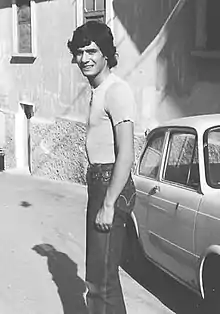Andrea Pazienza | |
|---|---|
 Pazienza in 1974 | |
| Born | 23 May 1956 San Benedetto del Tronto, Marche, Italy |
| Died | 16 June 1988 (aged 32) Montepulciano, Tuscany, Italy |
| Education | University of Bologna |
Andrea Pazienza (Italian: [patˈtsjɛntsa]; 23 May 1956 – 16 June 1988) was an Italian comics artist and painter.
Biography
Early life
Pazienza was born in San Benedetto del Tronto, province of Ascoli Piceno, in 1956. Growing up in his father's town of San Severo in Apulia, he enrolled in 1974 at the Department of Arts, Music, and Entertainment of the University of Bologna.[1]
Career
He made his debut in the spring of 1977 in the magazine Alteralter with his first comic story, "Le straordinarie avventure di Pentothal" (Pentothal's extraordinary adventures), the surrealistic and psychedelic story of an alter ego named after the sedative Penthothal. He later participated in such editorial experiences as Cannibale, Il Male, and Frigidaire, of which he was one of the founders.[2][3] In these publications, he created hundreds of comics, influenced by American underground comics and Walt Disney. He was especially fond of the character Goofy, which he appropriated for a humorous spoof on Italian hippiedom of the 1970s entitled Perché Pippo sembra uno sballato ("Why Goofy Looks Like a Pothead"), and a later, unfinished story entitled La leggenda di Italianino Liberatore ("The Legend of Italianino Liberatore", referring to his old friend Tanino Liberatore).
Pazienza developed a personal body of work, alternating between playful comic cartooning—at times politically charged–and much more elaborate, dark, disturbing graphic novels, often dealing with drugs and wanton violence, with a scattering of black humor throughout.
In 1980, he created the character Zanardi and collaborated with the magazines Corto Maltese and Comic Art, while also producing movie and theatre posters, scene designs, record covers, and advertising. He was extremely prolific through the 1980s, penning hundreds of single-panel cartoons as well as longer, intricate stories usually centred on Zanardi. Pompeo, his last graphic novel, which depicts the gradual downfall of a heroin addict (a largely autobiographical character) up to his eventual suicide, is generally considered his masterwork; the post-face to this work testifies that Pazienza tried to start a new life and, for a while, quit drugs.
Death and legacy
Andrea Pazienza died at age 32 in Montepulciano, from a heroin overdose.[4]
The nonprofit association Centro Fumetto Andrea Pazienza was created in his honour to help young cartoonists develop their skills.
In 2011, Andrea Pazienza was picked as the first of 150 Italians, a list of the country's most influential people, which was dedicated to the 150th anniversary of Italian unification.[5]
Selected works
- Aficionados
- Andrea Pazienza (1981)
- Le straordinarie avventure di Pentothal (1982)
- Milo Manara e Andrea Pazienza (1982) – referring to Milo Manara
- Zanardi (1983)
- Perché Pippo sembra uno sballato (1983)
- Pertini (1983) – an homage to former President of the Italian Republic Alessandro Pertini
- Glamour Book (1984)
- Tormenta (1985)
- Cattive Compagnie (1985)
- Glamour Book 2 (1987)
- Pazeroticus (1987)
- Zanardi e altre storie (1987)
- Pompeo (1987)
References
- ↑ Encyclopedia of Contemporary Italian Culture
- ↑ Federico Pagello (December 2012). "Cannibale, Frigidaire and the multitude: Post-1977 italian comics through radical theory". Studies in Comics. 3 (2): 231–251. doi:10.1386/stic.3.2.231_1.
- ↑ Simone Castaldi (2010). Drawn and Dangerous: Italian Comics of the 1970s and 1980s. Univ. Press of Mississippi. p. 8. ISBN 978-1-60473-777-6.
- ↑ Gino Moliterno, ed., Encyclopedia of Contemporary Italian Culture
- ↑ 150 Italiani — Un progetto a cura di Fabriano boutique (2011)